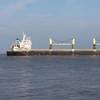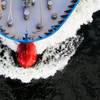Bridging the Trip Preparation Gap
Precision Is Imperative.
“Your true pilot cares nothing about anything on earth but the river, and the pride in his occupation surpasses the pride of kings.” – Mark Twain, Life on the Mississippi (1883)
The statement made by the great chronicler and river pilot himself over 130 years ago is arguably as true today as it was then. But what has changed dramatically in the six score and 10 years since is the variety and complexity of the daily challenges that river pilots confront in our modern world. The sophistication of locks, dams and the proliferation of bridges, the mercurial fluctuations in water levels and the consequences to those who fail to factor in all of the above when planning their commercial river trips can be career killers.
Even in Twain’s day, one key concern of any experienced river pilot was the depth, width and height of his own vessel and, as importantly, what his vessel was pushing or pulling. While those measurements were a constant for his vessel, the variances of the sizes of that day’s job were unpredictable. And, while water levels change and navigable channels widen and narrow, bridge heights don’t. It’s up to the pilot to make adjustments to his calculations and safety margins according to that day’s river conditions. If that isn’t done, the consequential bridge allision could be the beginning of a very long and difficult battle to defend a pilot’s license, career on the river and professional reputation. The case highlighted herein is not at all unusual in the set of facts, and sadly in its outcome as well.
A Case in Point
In late fall of 2011, our pilot was serving on board a towboat on a Midwest river and towing a 50’ x 50’ flexifloat spud barge astern. On board the barge were two observers and a deckhand. The towboat captain had towed flexifloat barges previously, but it was his first time towing this specific flexifloat spud barge. The trouble began when he ‘eye-balled’ that the spud height above the water was 35 feet. Unfortunately, he did not directly measure the spud height, inquire about the exact height or go on board the barge to check the height himself. What made matters worse, was the fact that these particular spuds could be positioned either all the way up or all the way down.
The captain commenced what was planned to be a four-mile transit route requiring passage under a vertical lift railroad bridge. The bridge, which has a vertical clearance of 35’ when down and 135’ when raised, was manned 24/7, and the operator could raise it partially or completely depending on the circumstances and communications received from approaching vessels via marine radio.
Seeing that the bridge was in the down position as he approached, the captain judged that “he could make it under the bridge without problems.” It was daylight; weather conditions were favorable with an ebb current and four nautical miles visibility.
The towboat passed under the railroad bridge with no problem, but as the flexifloat spud barge being towed astern was proceeding underneath the bridge, the spuds on the barge came in contact with the lower railroad steel beam of the bridge, resulting in damages to the spuds.
20/20 Hindsight
While the captain was assessing damage to the barge and attending to other onboard safety issues, like flooding and pollution, the bridge operator reported the incident to the Coast Guard which contacted the captain for confirmation that his tow had struck the bridge. The pilot confirmed the allision and reported that the lower two bolts of the forward spud well bent over but were still in the well, and the aft spud well’s upper bolts broke, causing the aft spud and well to bend backwards. He further reported no damage to his vessel or, to the best of his knowledge, the railroad bridge.
He promptly reported the incident to his license insurer and was immediately assigned a local maritime attorney who assisted in the completion and submission of the Marine Casualty Report (2692) and subsequently accompanied the river pilot to his Coast Guard interview.
The meeting was short; the licensed master was charged with negligence for both failing to check and verify the height/draft of the barge’s spuds, and failing to request the operator to raise the bridge. He was then offered a Settlement Agreement stipulating an outright three-month license suspension with an additional nine-month probationary period following the completion of his ‘beach’ time.
After debating the merits of contesting the terms of the Settlement Agreement, both the captain and his attorney agreed that, given the absence of mitigating circumstances, the most prudent, yet painful, decision was to accept the suspension with probation offer.
Because he had wisely opted for income protection on his license insurance policy, he received his insured wages for the duration of his suspension, but no amount of money could compensate the hit to his professional reputation caused by two fleeting lapses in judgment: not verifying the spud’s height and/or not requesting the bridge to be raised.
Since we began this column with an upbeat quote from Mark Twain, it’s only fitting that we go back a little further in time to ancient Greece and the sobering yet thoughtful words of Sophocles: “Men of ill judgment oft ignore the good that lies within their hands, till they have lost it.”
(As published in the September 2013 edition of Marine News - www.marinelink.com)














